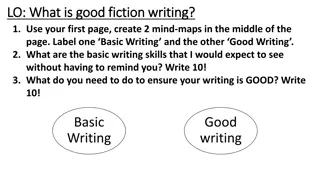Writing Position Descriptions Best Practices
Learn about the importance of position descriptions (PDs) in HR management. Discover how to write effective PDs, their purpose and uses, and who is responsible for creating and updating them. Gain insights on classifying positions and utilizing PDs for recruitment, evaluation, and organizational management.
Download Presentation

Please find below an Image/Link to download the presentation.
The content on the website is provided AS IS for your information and personal use only. It may not be sold, licensed, or shared on other websites without obtaining consent from the author.If you encounter any issues during the download, it is possible that the publisher has removed the file from their server.
You are allowed to download the files provided on this website for personal or commercial use, subject to the condition that they are used lawfully. All files are the property of their respective owners.
The content on the website is provided AS IS for your information and personal use only. It may not be sold, licensed, or shared on other websites without obtaining consent from the author.
E N D
Presentation Transcript
Welcome Morris A Blakely, Lead HR Specialist Position Management and Classification HR Strategy and Evaluation Solutions Office of Personnel Management www.opm.gov/HRS 2
Agenda Position Descriptions (PD s) PD Requirements Purpose and Uses Writing the PD Types of PD s Questions/Comments www.opm.gov/HRS 3
Position Descriptions A position description is a written statement of the major duties, responsibilities, and organization relationships of a given position. Provides a permanent record of duties and responsibilities so that the position can be classified as to title, series, and grade. All PD s must be signed by the immediate supervisor who certifies to the accuracy of the PD. PD s should be reviewed and updated annually. Helpful Hint: A great time to review and update a PD is prior to recruiting for the position. www.opm.gov/HRS 4
Position Description Purpose and Uses Purpose Provide an official record of work to be performed by an employee Uses Determine qualification requirements and evaluate qualifications in recruiting, examining, selection, and promotion actions Informing employees or applicants about duties and responsibilities Analyzing training needs Developing career ladders and career development programs Reviewing job content and establishing performance standards Developing and studying work flow patterns and organizational structures www.opm.gov/HRS 5
Position Description Uses Uses Detecting duplication of work or overlapping responsibilities Establishing competitive levels for reduction-in-force As basic evidence in appeals cases Determine bargaining unit coverage www.opm.gov/HRS 6
Writing the PD Who Does What? Supervisor or Manager Responsible for ensuring the facts presented in a PD are current and accurate and must certify as such. Concentrate primarily on describing the major duties of the position and what is needed to accomplish the mission of the organization. Classifiers Advise supervisors or managers on how to write position descriptions. Reviewing draft PD s for adequacy (i.e., to ensure clarity, format, length, and inclusion of information necessary to determine title/series/grade. Writing or assisting in writing PD s when asked. Ensuring that major duties and factor level descriptions are related appropriately. www.opm.gov/HRS 7
Writing the PD What Should Be in the PD? Major duties and responsibilities (percentage of time spent on each is helpful) Duties currently assigned (not projected duties unless job is new and duties can only be anticipated) Observable duties Duties identified with the position s purpose and organization Duties expected to continue or recur on a regular basis over a period of time, such as one year *Other duties as assigned. Helpful Hint: Concentrate on the position, not the person. www.opm.gov/HRS 8
Writing the PD Things to Do Use Factor Evaluation System (FES) Format for non- supervisory positions, when possible. Ensure you have all significant facts about the position Identify major duties and responsibilities and combine related duties into major duty paragraphs. Arrange major duties in logical order (importance; performance; time devoted to each, etc.) Include percentages of time devoted to each major duty. Helpful Hint: Mission statements, functional statements and organizational charts are all helpful when writing a PD. www.opm.gov/HRS 9
Writing the PD Things to Remember No Fluff Stick to the facts and describe the major duties fully and accurately. Avoid writing a PD to get a grade . Classification is not intended to be a performance or recruitment flexibility. Use the classification standards but try not to copy them. Automated classification tools, PD Libraries, and previously classified PD s are a great way to get past the blank page syndrome . Work with your classifier. We re here to help you get what you need for your organization! www.opm.gov/HRS 10
Writing the PD When Should Changes Be Made? Anytime when: There is a change in major duties and responsibilities Program changes occur due to mission, technology, or organizational structure that bear on the position Change in guidelines, organizational level, or nomenclature www.opm.gov/HRS 11
Types of Position Descriptions There are several different types of position descriptions. Standardized Mixed Grade Mixed Series Supervisory/Leader www.opm.gov/HRS 12
Types of PDs - Standardized A standardized PD is description of major duties and responsibilities known to be representative of a considerable number of positions. Benefits Facilitate classification consistency Save time writing PDs Expedite staffing and recruitment actions Less costly than writing individual PDs Supportive of relativity between positions across the organization/department Flexibility of assignments www.opm.gov/HRS 13
Types of PDs - Standardized Risks Inappropriately classified generics may spread misclassification across many positions PDs too generic to develop appropriate recruitment announcements, performance standards, identify training needs, or make reassignments In RIF situation, competitive levels may be too broad so that positions cannot be accurately targeted resulting in inability to accomplish mission www.opm.gov/HRS 14
Types of PDs Mixed Grade Although a few positions include only work of a single grade level, there are many positions where work encompasses several different grade levels. The highest-graded duties may be grade controlling only if those duties: Are regular and recurring Are performed at least 25% of the time Involve a higher level of knowledge and skill that is a factor in recruiting for the position www.opm.gov/HRS 15
Types of PDs Mixed Series A mixed series position involves work covered by more than one occupational series. Factors considered when determining the proper series: Paramount knowledge required Purpose of the position Organizational function in which the position is located Lines of promotion within the organization Recruitment source www.opm.gov/HRS 16
Types of PDs Supervisory A supervisory position accomplishes department objectives by providing technical and administrative supervision of staff while also organizing and monitoring work processes. Supervisors have the authority to assign work to a designated group of employees, evaluate performance of employees in carrying out the work, take disciplinary action as required, make selections, and other essential personnel management functions. All supervisory PD s must have a supervisor duty paragraph describing the supervisor duties performed. These duties must be performed at a minimum of 25% of the time. www.opm.gov/HRS 17
Types of PDs Leader Positions Part I Work Leaders lead three or more employees in clerical or other one-grade interval occupations in the General Schedule in accomplishing work. Part II Team Leaders primary purpose is, as a regular and recurring part of their assignment and at least 25% of their duty time, to lead a team of other General Schedule (GS) employees in accomplishing two-grade interval work that meets at least the minimum requirements of Part II. Lead positions perform work of the same kind and level as highest level of work accomplished by team. www.opm.gov/HRS 18
Questions/Comments? Morris A. Blakely Morris.Blakely@opm.gov www.opm.gov/HRS 19























